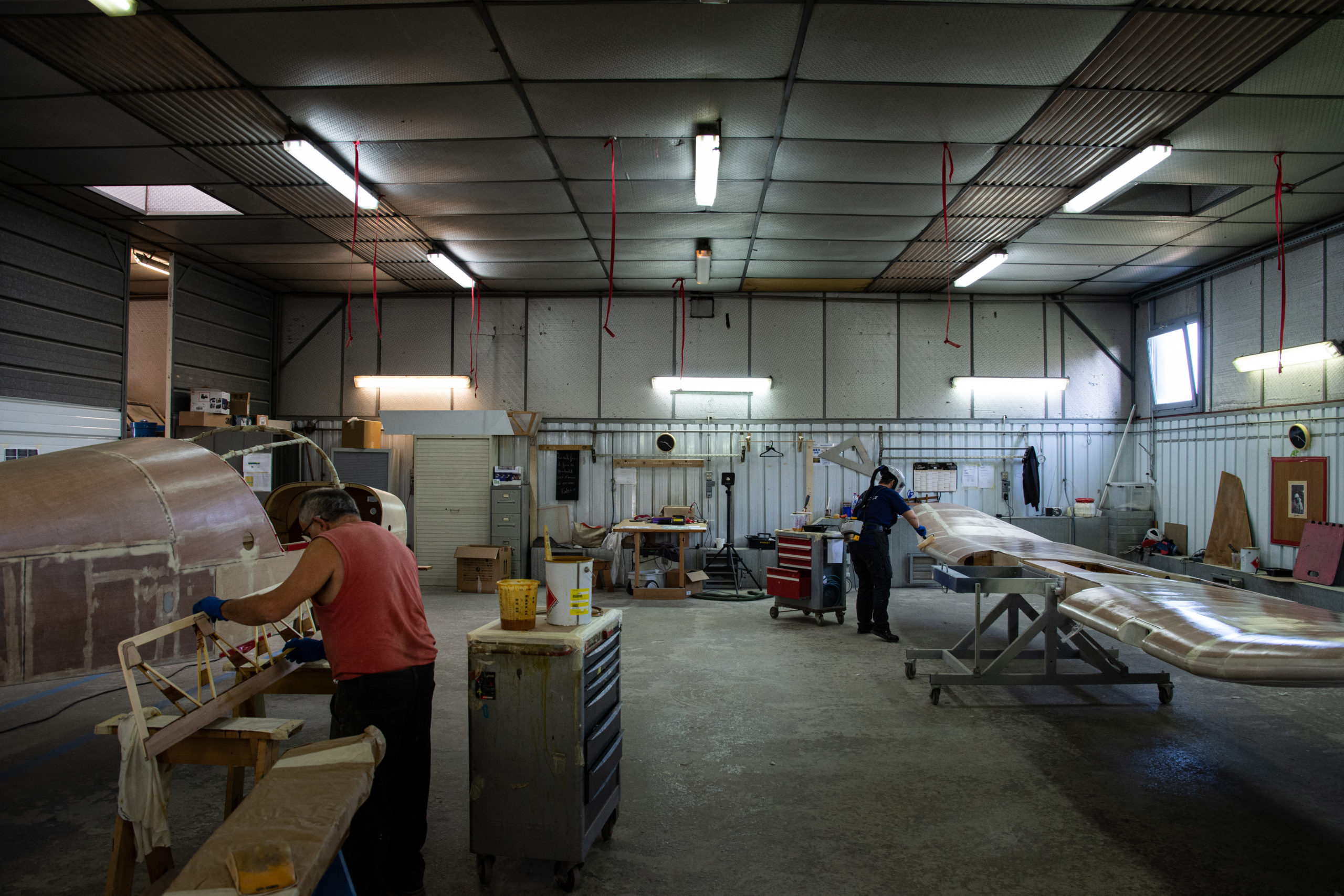When we get to this off-the-way workshop, the first thing you can smell is glue. But the most striking thing remains the sight of those two astronaut silhouettes in T-shirts cutting and sawing around. Like tailors from outer space.

Short sleeves and full face helmet attached by a tube to a futuristic belt, the first silhouette is bent over a wing rib, just a few centimeters away from his work, stitching imperturbably. The other is cutting undesirable fringes off the translucent cloth on the other side of the wing. One could almost expect to hear them breathe like a deep-sea diver. This is when one could notice the unusual silence in this workshop. This is the only workshop at Robin where one can hear his own thoughts at all times. Both silhouettes thus seem to be able to concentrate fully on this crucial task of theirs. They are so focused that you could actually swear they were working on a one-of-kind-dress for some royal wedding.
Our presence finally pulls them out of focus. We’re almost sorry to distract them, but we would very much like to talk.
The first silhouette to let go of the full-face-helmet to replace it with a somehow more humane face mask is Romain.
Romain has been at Robin for six years, which makes him almost one of the oldest worker around considering the current renewal rate indexed on the growing retirement rate. Woodworker until not long ago, he decided to try something new right when the interlining workshop changed location from the wood work shop to here, closer to the painting workshop. There, he found James to teach him the tricks of the trade. James never did anything else than interlining, he is what you call an absolute specialist. In 35 years at Robin, he’s seen his fair share of adventure. But as a man of few words, he lets Romain tell us about him: « for the canvas to be sufficiently stretched over the structure, the simplest way is to pull it step by step using staples, which is what I do. But not James. James pulls the whole canvas at once using only his arms and handgrip. » At this point, Romain pats the wing interlined by James right next to us. The noise this makes is very pure, and different every time, depending on were you tap between the wing ribs. You could play a very smooth drum solo on this.

« The plane could actually fly like this, with just canvas over his wood. But not indefinitely of course, not if paint and primer layers aren’t applied. » says Romain.
All this gives us a fair idea of the importance of interlining in the fabrication process: what would an albatross be without feathers? He’d be grounded like a penguin, yes, you could put it this way if you like.
But let’s get back to our hosts. This exact representation of the generational cohabitation currently going on at the Darois factory is actually the crucial link between woodworkers and painters. And this link needs to be reinforced. That’s why Jordan will be joining them shortly. Jordan is still a painter, but is about to start learning about interlining to assist James along with Romain. Adaptability is everything when it comes to working in such a company. And the strangest part is that James will not be the one to teach Jordan. It will be Romain. And this time, James greets us with his own words, through the steamy glass of his helmet: « Romain learned very well in a short time. He brought his own vision and methods. In some ways, he’s more up to date than I am. I still do it like in the old days. » Romain seems proud to hear that, and happy overall. he says if things keep going the way they are, one day he’ll wake up and have as many years at Robin as James does.

But for now, James is still the one doing the stitching. Sewing the canvas to the edges of the wing ribs is way more complicated than it looks. It is actually the most demanding operation in interlining. But Romain is learning fast enough to then teach someone else soon enough and so on.
Canvas, threads, needles and glue… And even an iron. But this is no luxury touch. The heat simply enables the canvas, once it is sewed and glued on the structure, to tighten up a bit more before primers are applied in the next workshop.
So it’s not like making a royal wedding dress after all. For such a figure-hugging dress would be, to say the least, most awfully shocking, even for a runaway princess. The point is to hand-tailor a very tight leotard for the wing, with absolutely no room for imperfection whatsoever.
Thus, and only thus can the DR401 find his perfect shape, that shape the wind knows so well how to caress.




Leave a comment